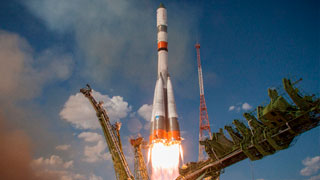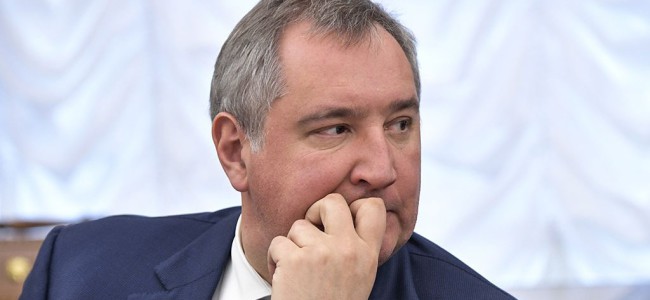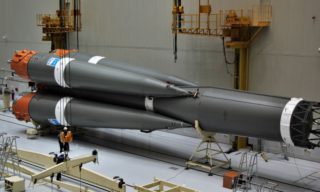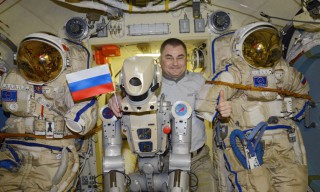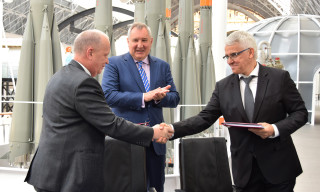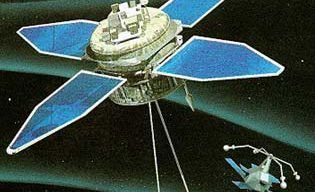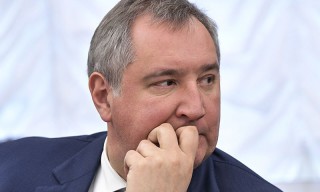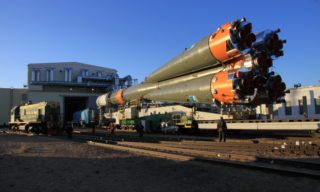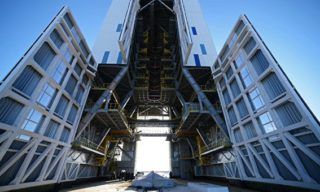Russia Wants to Extend U.S. Space Partnership. Or It Could Turn to China.
The New York Times
By Andrew E. Kramer
Dec. 11, 2018
Russia’s Museum of Cosmonautics displays with rightful pride artifacts from its early years of storied achievements in space exploration: the first satellite, the first dog in space, the first man and, soon thereafter, the first toolbox.
Labeled in blocky Cyrillic writing a “panel with instruments for technical service and repair,” the toolbox held an array of handy items like pliers, two wooden-handled files and a hacksaw, spare blade included.
Russian space officials are trumpeting this history of grit and ingenuity in orbit as they hope to persuade Washington to continue joint piloted exploration in the next decade rather than split into separate paths. They face significant hurdles.
The American incentives for engaging with Russia in space in the 1990s — political goals like the employment of idle rocket scientists to prevent missile proliferation — have mostly disappeared with the resumption of tensions.
The Trump administration has already proposed that by 2025 the United States should stop supporting the International Space Station, which is the principal joint project today. A final decision is up to Congress. The American role might be shifted to a commercial footing thereafter.
In its place, NASA plans to place a habitable station called Gateway in orbit around the moon and send probes to the surface, while testing technologies for possible trips to Mars.
Further complicating matters are the plans by some entrepreneurs to create private space stations for space tourism.
The talks between Russia and the United States promise to be difficult, and they have not been helped by a mysterious incident on the International Space Station. In August, a hole was discovered in the wall of a Russian Soyuz capsule docked to the station; air was leaking out.
Dmitri O. Rogozin, the director of Russia’s space agency, said in an interview that the hole had been drilled in a deliberate act of sabotage, but it remains unclear whether this happened before launch or in orbit.
“It was intentional damage to the ship, we are convinced of this now,” Mr. Rogozin said of the hole, about the size of a pencil eraser. Cosmonauts on board patched it with specialized tape. “This was intentional action; manual, intentional action.”
Russian news media outlets have speculated wildly about NASA astronauts sabotaging the Russian capsule. The United States commander of the International Space Station at the time denied the accusations.
The capsule was launched in June but started leaking air only weeks later, suggesting that if the hole had been drilled before launch it must have been plugged with a sealant that broke down over time and was sucked into the vacuum of space.
On Tuesday evening in Moscow, two Russian cosmonauts, Sergey Prokopyev and Oleg Kononenko, exited the station for a spacewalk to investigate the exterior of the capsule. They planned to remove a panel from the craft and return it to Earth for an examination for signs of leaked sealant.
The investigation has to be conducted in space, as the portion of the Soyuz ship with the hole is designed to separate and burn during re-entry, meaning that it cannot be examined on the ground.
Mr. Rogozin said he and Jim Bridenstine, the NASA administrator, had agreed not to speculate on the causes or the political implications of the matter until the investigation is completed. Whether the hole affects talks on future space cooperation, Mr. Rogozin said, “depends on the result of the investigation.”
The mystery of the hole notwithstanding, it is unclear how much longer the post-Soviet era of space cooperation between the United States and Russia can last in the more hostile environment now surrounding relations.
In the interview, Mr. Rogozin said Russia wanted to carry on joint flights with the United States and its allies, despite the tensions over election interference, wars in Syria and Ukraine, and the chemical weapons poisoning of a former double agent in Britain.
The American and Russian piloted space programs should remain merged, he said, as a symbol of coexistence and the peaceful pursuit of science. He also argued that it would be a mistake to leave the Russians out of any risky venture in space.
Russian hardware would provide a safety net if something went wrong near the moon, he said, just as Russian rockets were able to supply the International Space Station after the Space Shuttle Columbia disaster in 2003, which grounded the shuttle program for more than two years.
“Even if Americans make their own lunar transport system, there should always be a reserve, for the safety of the crew,” he said. “That reserve can exist only if a partner — and now only Russia can do this, and nobody else — has another, alternative transport system capable of saving the astronauts in case of a very problematic situation.”
Analysts say Moscow has a strong incentive to maintain the joint program: a decided lack of money to pursue a lunar station on its own. Russia’s budget for its space program is something less than one-tenth what the United States spends on NASA.
Mr. Bridenstine, the NASA chief, has said he would like Russia to participate in the lunar program, and he temporarily lifted sanctions imposed on Mr. Rogozin during the Ukraine crisis so that he could pay a visit and continue the talks.
The negotiations opened in October in Baikonur, the Russian-operated spaceport in Kazakhstan, where a Russian Soyuz rocket carrying a cosmonaut and an astronaut failed in flight, though an emergency escape system propelled their capsule to a harrowing but safe return.
“I’m not surprised by their support and how well they worked,” Nick Hague, the American astronaut on board the faulty rocket, said in an interview on NASA television of the Russian system and quick work of search and rescue crews. “It’s on display every day over there.”
The Russians successfully launched a fresh crew to the station on the same model of rocket on Dec. 3.
Russia’s preference is to press on with a space program entwined with the United States’, on either the lunar program or another venture, Mr. Rogozin said. But if talks fail, Russia can turn to China or India for partnership.
“China is offering many initiatives for cooperation, is asking us to help them develop, though they have already achieved a good level of development,” he said. “They are suggesting creating a joint station.”
There might then be two stations circling the Earth or the moon, one led by the United States, the other a Russian-Chinese enterprise. Mr. Rogozin even floated the idea of a “BRIC station,” the acronym for the developing economies of Brazil, Russia, India and China.
Mr. Rogozin in November ordered the Russian Academy of Sciences to study the prospects for a solo Russian program to build a habitable base on the surface of the moon.
Ivan M. Moiseyev, the director of the Institute of Space Policy in Moscow, said in a telephone interview that any proposal for a lone Russian lunar station was fantastical, given the budget constraints. “The technical capability exists, but the finances don’t.”
The Soviet Union, though beaten to the moon by the United States, was no slouch in lunar exploration. The Soviet Union was the first to photograph the far side of the moon and to land a rover and return a sample robotically. But it canceled its piloted program in the 1970s rather than strive for a second-place landing. “We were close,” Mr. Moiseyev said.
Separate programs today, Mr. Rogozin said, are a fallback option. “It wouldn’t be right,” he said, to plan for a future of piloted flight after the International Space Station with multiple, competing national programs or alliances.
What Russia can offer, Mr. Rogozin said, is a margin of safety for any future moon orbiting station.
Over decades operating the Salyut and later Mir space stations, Russian cosmonauts tackled a range of in-flight emergencies and repairs ranging from fires to collisions that made the Russian program look like an orbiting Murphy’s Law. But they survived.
“It’s better, cheaper and safer to go together,” Mr. Rogozin said. “Politicians will say, ‘Let’s do it alone,’ but politics ends where the opinion of a serious scientist begins. That’s what I say.”
If the United States chooses to exclude Russia, and an emergency arises, he said, “Who will answer for that?”


